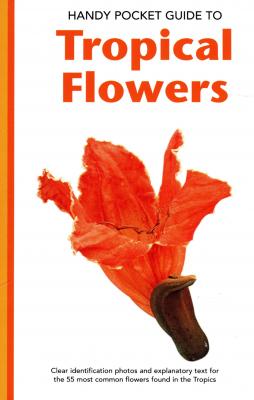Handy Pocket Guide to Tropical Flowers. William Warren
Читать онлайн.| Название | Handy Pocket Guide to Tropical Flowers |
|---|---|
| Автор произведения | William Warren |
| Жанр | Биология |
| Серия | Handy Pocket Guides |
| Издательство | Биология |
| Год выпуска | 0 |
| isbn | 9781462907335 |
HANDY POCKET GUIDE TO
Tropical
Flowers
Text by William Warren
Photography by Luca Invernizzi Tettoni
Published by Periplus Editions (HK) Ltd., with editorial offices at 364 Innovation Drive North Clarendon, VT 05759 and 61 Tai Seng Avenue #02-12, Singapore 534167.
Copyright © 2004 Periplus Editions (HK) Ltd.
ALL RIGHTS RESERVED
Printed in Singapore.
ISBN: 978-1-4629-0733-5 (ebook)
Distributors
Indonesia
PT Java Books,
Kawasan Industri Pulongadung
Jl. Rawa Gelam IV No.9
Jakarta 13930, Indonesia
Tel: (62-21) 4682 1088 Fax: (62-21) 461 0207
Email: [email protected]
Japan
Tuttle Publishing
Yaekari Building 3rd Floor
5-4-12 Osaki, Shinagawa-ku
Tokyo 141 0032
Tel: (03) 5437 0171 Fax: (03) 5437 0755
Email: [email protected]
North America, Latin America & Europe
Tuttle Publishing
364 Innovation Drive
North Clarendon, VT 05759-9436
Tel: (802) 773 8930 Fax: (802) 773 6993
Email: [email protected]
Asia Pacific
Berkeley Books Pte Ltd
61 Tai Seng Avenue #02-12,
Singapore 534167
Tel: (65) 6280 1330 Fax: (65) 6280 6290
Email: [email protected]
05 07 09 08 06
4 6 7 5 3
Introduction
The first Southeast Asian gardens, in the Western sense of the term, were those planted around royal palaces and Buddhist or Hindu temples. From written accounts, we know that these included trees and shrubs sometimes selected purely for their ornamental qualities but more often because of their symbolic associations and use in ceremonies. In the earliest days the plants were nearly all native to the region, but these were later joined by countless introduced specimens, to such an extent that few, if any, of the surviving landscapes bear much resemblance to their original composition. The gardens of ordinary homes were similarly prescribed by tradition, serving utilitarian rather than decorative aims. The majority of the specimens produced edible fruits or leaves and roots that could be used in cooking or traditional medicine.
All this began to change with the arrival of outsiders, mainly Europeans, who brought with them not only new concepts of garden design (and purpose) but also new ornamentals to enhance them. The movement of plant materials around the world during the past 500 years is an extraordinary story, nowhere more so than in tropical regions where the climate enabled introduced species to become established within a short time.
Take, for instance, the now ubiquitous chilli pepper, essential to a dozen or so cuisines. This pungent little fruit was unknown outside its native tropical America before Columbus made his historic voyage toward the end of the 15th century, one of his objectives being to discover the source of the black pepper then so coveted in Europe. Precisely how and when chillies made their way to Asia is unknown, but they were almost certainly brought by some of the Western explorers who came in the next century and rapidly became such an integral part of various cultures it is difficult to imagine their absence.
The same thing happened with countless ornamental plants. These came primarily from Central and South America, but also from Africa, remote islands like Madagascar, and arid Australia. Every Southeast Asian garden today displays evidence of this great botanical migration through such now common species as the Acacia and the Flame Tree, the Allamanda and the Bougainvillea, the Canna and the Heliconia. Some came early and haphazardly. Others were introduced more systematically through the great 19th-century botanical gardens. With few exceptions, they adapted quickly, and many soon could be found growing as wild as real natives. The process still continues. Visit any nursery plant market in Jakarta, Singapore, or Bangkok today, and you will find specimens that have yet to acquire local cultural associations, sometimes even local names. Come back in a few years, though and they may well be relatively commonplace.
The entries in this book are arranged according to family, in alphabetical order. An index which includes the common and scientific names can be found at the back of the book.
Globe Amaranth
Gomphrena globosa
Botanical Family: Amaranthaceae
Thai name: Ban-mai-ru-ruey
Malay names: Ratnapakaya, Bunga kancing, Gomfrena
Indonesian names: Ratnapakaya, Bunga kancing, Gomfrena
Though native to more arid regions of the New World, this small, shrubby annual—also popularly called Batchelor's Buttons—is widely grown in most of Southeast Asia thanks to its profusion of long-lasting flowers. These are globular in shape and actually consist of numerous individual flowers, each enclosed by papery petals; the most common color is magenta, but there are also white and pale mauve varieties. Blooming occurs for around three months during the rainy season, inspiring one of its Indonesian names which translates as the "three-month flower." The flowers retain their color for more than a week.
The flowers are used in Bali in religious offerings (above right) and to decorate sacred flags, while in Thailand they form the most important component of a traditional floral arrangement in which blooms are imbedded in shaped mounds of damp sawdust. To the confusion of visiting plant collectors, Thais often dye the flowers, producing unusual colors never seen in nature.
Spider Lily
Crinurn asiaticum
Botanical Family: Amaryllidaceae
Thai name: Plub-plueng
Malay names: Krinum bakung
Indonesian name: Krinum bakung
This handsome Crinum is native to Southeast Asia and is seen not only growing wild in swamps but also in many garden plantings, thanks to its willingness to tolerate a wide range of conditions; including strong sea winds. It has a massive, fleshy stem that grows to a height of about a meter and long, succulent, bright-green leaves. The flowers, which appear frequently on stalks in a sunburst
